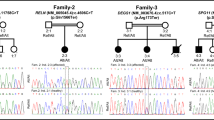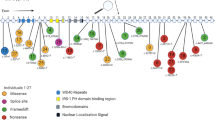Abstract
Cerebral cavernous malformations (CCMs) are vascular abnormalities of the brain that can result in hemorrhagic stroke and seizures. Familial forms of CCM are inherited in an autosomal-dominant fashion, and three CCM genes have been identified. We recently determined that large genomic deletions in the CCM2 gene represent 22% of mutations in a large CCM cohort from the USA. In particular, a 77.6 kb deletion spanning CCM2 exons 2–10 displays an identical recombination event in eight CCM probands/families and appears to be common in the US population. In the current study, we report the identification of six additional probands/families from the USA with this same large deletion. Haplotype analysis strongly suggests that this common deletion derives from an ancestral founder. We also examined an Italian CCM cohort consisting of 24 probands/families who tested negative for mutations in the CCM1, CCM2, and CCM3 genes by DNA sequence analysis. Surprisingly, the common CCM2 deletion spanning exons 2–10 is not present in this population. Further analysis of the Italian cohort by multiplex ligation-dependent probe analysis identified a total of ten deletions and one duplication. The overall spectrum of genomic rearrangements in the Italian cohort is thus quite different than that seen in a US cohort. These results suggest that there are elements within all three of the CCM genes that predispose them to large deletion/duplication events but that the common deletion spanning CCM2 exons 2–10 appears to be specific to the US population due to a founder effect.


Similar content being viewed by others
References
Rigamonti D, Hadley MN, Drayer BP, Johnson PC, Hoenig-Rigamonti K, Knight JT, Spetzler RF (1988) Cerebral cavernous malformations. Incidence and familial occurrence. N Engl J Med 319:343–347
Tomlinson FH, Houser OW, Scheithauer BW, Sundt TM Jr., Okazaki H, Parisi JE (1994) Angiographically occult vascular malformations: a correlative study of features on magnetic resonance imaging and histological examination. Neurosurgery 34:792–799 discussion 9–800
Gil-Nagel A, Wilcox KJ, Stewart JM, Anderson VE, Leppik IE, Rich SS (1995) Familial cerebral cavernous angioma: clinical analysis of a family and phenotypic classification. Epilepsy Res 21:27–36
Zabramski JM, Wascher TM, Spetzler RF, Johnson B, Golfinos J, Drayer BP, Brown B, Rigamonti D, Brown G (1994) The natural history of familial cavernous malformations: results of an ongoing study. J Neurosurg 80:422–432
Zabramski JM, Henn JS, Coons S (1999) Pathology of cerebral vascular malformations. Neurosurg Clin N Am 10:395–410
Dubovsky J, Zabramski JM, Kurth J, Spetzler RF, Rich SS, Orr HT, Weber JL (1995) A gene responsible for cavernous malformations of the brain maps to chromosome 7q. Hum Mol Genet 4:453–458
Günel M, Awad IA, Anson J, Lifton RP (1995) Mapping of a gene causing cerebral cavernous malformation to 7q11.2-q21. Proc Nat Acad Sci 92:6620–6624
Marchuk DA, Gallione CJ, Morrison LA, Clericuzio CL, Hart BL, Kosofsky BE, Louis DN, Gusella JF, Davis LE, Prenger VL (1995) A locus for cerebral cavernous malformations maps to chromosome 7q in two families. Genomics 28:311–314
Craig HD, Gunel M, Cepeda O, Johnson EW, Ptacek L, Steinberg GK, Ogilvy CS, Berg MJ, Crawford SC, Scott RM, Steichen-Gersdorf E, Sabroe R, Kennedy CTC, Mettler G, Beis MJ, Fryer A, Awad IA, Lifton RP (1998) Multilocus linkage identifies two new loci for a Mendelian form of stroke, cerebral cavernous malformation, at 7p15–13 and 3q25.2–27. Hum Mol Genet 7:1851–1858
Labauge P, Enjolras O, Bonerandi JJ, Laberge S, Dandurand M, Joujoux JM, Tournier-Lasserve E (1999) An association between autosomal dominant cerebral cavernomas and a distinctive hyperkeratotic cutaneous vascular malformation in 4 families. Ann Neurol 45:250–254
Sahoo T, Johnson EW, Thomas JW, Kuehl PM, Jones TL, Dokken CG, Touchman JW, Gallione CJ, Lee-Lin SQ, Kosofsky B, Kurth JH, Louis DN, Mettler G, Morrison L, Gil-Nagel A, Rich SS, Zabramski JM, Boguski MS, Green ED, Marchuk DA (1999) Mutations in the gene encoding KRIT1, a Krev-1/rap1a binding protein, cause cerebral cavernous malformations (CCM1). Hum Mol Genet 8:2325–2333
Liquori CL, Berg MJ, Siegel AM, Huang E, Zawistowski JS, Stoffer T, Verlaan D, Balogun F, Hughes L, Leedom TP, Plummer NW, Cannella M, Maglione V, Squitieri F, Johnson EW, Rouleau GA, Ptacek L, Marchuk DA (2003) Mutations in a gene encoding a novel protein containing a phosphotyrosine-binding domain cause type 2 cerebral cavernous malformations. Am J Hum Genet 73:1459–1464
Denier C, Goutagny S, Labauge P, Krivosic V, Arnoult M, Cousin A, Benabid AL, Comoy J, Frerebeau P, Gilbert B, Houtteville JP, Jan M, Lapierre F, Loiseau H, Menei P, Mercier P, Moreau JJ, Nivelon-Chevallier A, Parker F, Redondo AM, Scarabin JM, Tremoulet M, Zerah M, Maciazek J, Tournier-Lasserve E (2004) Mutations within the MGC4607 gene cause cerebral cavernous malformations. Am J Hum Genet 74:326–337
Bergametti F, Denier C, Labauge P, Arnoult M, Boetto S, Clanet M, Coubes P, Echenne B, Ibrahim R, Irthum B, Jacquet G, Lonjon M, Moreau JJ, Neau JP, Parker F, Tremoulet M, Tournier-Lasserve E (2005) Mutations within the programmed cell death 10 gene cause cerebral cavernous malformations. Am J Hum Genet 76:42–51
Liquori CL, Berg MJ, Squitieri F, Leedom TP, Ptacek L, Johnson EW, Marchuk DA (2007) Deletions in CCM2 are a common cause of cerebral cavernous malformations. Am J Hum Genet 80:69–75
Felbor U, Gaetzner S, Verlaan DJ, Vijzelaar R, Rouleau GA, Siegel AM (2007) Large germline deletions and duplication in isolated cerebral cavernous malformation patients. Neurogenetics 8(2):149–153
Gaetzner S, Stahl S, Surucu O, Schaafhausen A, Halliger-Keller B, Bertalanffy H, Sure U, Felbor U (2007) CCM1 gene deletion identified by MLPA in cerebral cavernous malformation. Neurosurg Rev 30(2):155–159
Squitieri F, Maglione V, Buzzi MG, Nargi E, Novelletto A, Cannella M, Simonelli M, Colonnese C, Simonelli P, Innocenzi G, Gabliardi FM, Caruso R, Ragona G, Cantore GP (2000) Cavernous angiomas of the nervous system in Italy: clinical and genetic study. Neurol Sci 21:129–34
Laberge-le Couteulx S, Jung HH, Labauge P, Houtteville JP, Lescoat C, Cecillon M, Marechal E, Joutel A, Bach JF, Tournier-Lasserve E (1999) Truncating mutations in CCM1, encoding KRIT1, cause hereditary cavernous angiomas. Nat Genet 23:189–193
Fiscella K, Fremont AM (2006) Use of geocoding and surname analysis to estimate race and ethnicity. Health Serv Res 41:1482–1500
Acknowledgments
We are grateful to the CCM patients and their families for participation in this study. This work was supported by NIH grant NS43543 to D.A.M.; NRSA grant 1 F32 NS51082-03 to C.L.L.; Italian National Research Council Short-term Mobility Program to F.G.; Lega Italiana Contro l’Epilessia grant to S.P. and Italian Health Ministry COFIN grant to F.S. The financial support of Telethon-Italy (Grant No. GGP07170) is gratefully acknowledged.
Author information
Authors and Affiliations
Corresponding authors
Additional information
Christina L. Liquori and Silvana Penco contributed equally to this work.
Rights and permissions
About this article
Cite this article
Liquori, C.L., Penco, S., Gault, J. et al. Different spectra of genomic deletions within the CCM genes between Italian and American CCM patient cohorts. Neurogenetics 9, 25–31 (2008). https://doi.org/10.1007/s10048-007-0109-x
Received:
Accepted:
Published:
Issue Date:
DOI: https://doi.org/10.1007/s10048-007-0109-x




